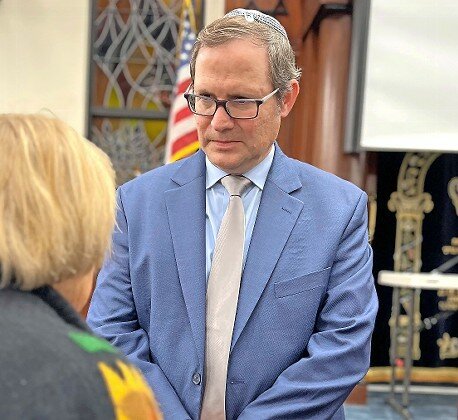On its anniversary, Kristallnacht is linked to Oct. 7
In the wake of the Hamas terror attacks on Oct. 7, people searching for historical antecedents sometimes cited Kristallnacht, the “night of broken glass” in Germany on Nov. 9 and 10, 1938.
“This is not the first time that Kristallnacht is associated with a Jewish tragedy,” explained Dr. Shay Pilnik during a lecture on the broad historical context of Kristallnacht, at the Young Israel of North Woodmere on Nov. 7.
“After the Pittsburgh synagogue shooting, there were some rabbis who drew the comparison between Pittsburgh, between the killing of 11 Jews at the synagogue, and Kristallnacht,” where at least 91 Jews were slain.
“But we have to recognize the limitations of this comparison,” said Pilnik, director of the Fish Center for Holocaust and Genocide Studies at Yeshiva University, who explained that despite the deaths, “Kristallnacht was not so much oriented towards Jewish lives, but rather Jewish institutions.” In just a few hours, it destroyed 267 synagogues and 7,500 Jewish businesses throughout Germany. “Jews knew that from that point on, their public life was completely shattered.”
“The aim was to shake German Jewry, and to destroy the public presence, the public expression of Jewish life, in Germany.”
“I still think about a lot of similarities between what we just witnessed,” he continued. “I am Israeli, born in Israel, so I experienced a number of wars, I served in the Army, there were two intifadas, two wars in Lebanon. But I never really had any kind of a feeling that when I read the history [of Kristallnacht], I can say this is something that I have lived through.” Until now.
He recounted the story of a Jew who was asked to move from first-class to third-class on a train in 1935. “He came to a Nazi officer and insisted, I bought a ticket for first-class and I deserve to be here. And the officer accepted that ticket. In other words, there was still a sense, until Kristallnacht, that this is a place where you can live — as a second class citizen, you know you’re not equal, but you have a government that would somehow protect you, police that will protect you. And then it is all shattered violently.”
He said that what happened on Oct. 7 “frighteningly gave us a glimpse into what happens when order turns into disorder — and what happens when Nazis can do whatever they want without anyone who can stop them.”
A comparison between Hamas with the Nazis is an apt one, he said, recalling that the Jerusalem mufti, leader of the Palestinians in the 1930s, was the link between the two.
Did a culture of silence, or indifference, mute reaction to Kristallnact, similar to what some observers have reported following Oct. 7?
Most Germans did not participate in Kristallnacht and were not necessarily pleased with it, “because they understood that this was an act of terror by a terrorist regime and that, you know, if my Jewish neighbor is being attacked, his apartment is being ransacked, his father is being shot, what’s going to happen to me? Maybe I will turn into an enemy of the regime.”
But “very few people show bravery to purposefully walk into a jewelry store to try to clean up, or into synagogues to save Torah scrolls,” he said. “The majority of them respond with this indifference.”
The “reaction of the world leaders was of expressed horror, but ultimately, indifference as well.”
“When you think about the world reaction, on Oct. 8 and 9, to Jewish suffering, for me, it rang a bell that there was a reaction, but the reaction was very brief. And ultimately, once the reaction is costly for politicians, they stop feeling so sorry for us.”
“For as long as there are Jews, there are antisemites,” he said. “We have an obligation to remember and an obligation to fight.”
Pilnik concluded with a hopeful thought, describing an encounter with a Moroccan student in a college course on basic Judaism where none of his students were Jewish.
“At the end of the quarter, she says, professor, this class changed my life. And I said, why? And she said, I would like to be a diplomat, I would like to work on Moroccan-Israeli relations. But I have to tell you, what you taught me here stands in complete contrast to what I was taught in elementary school, middle school and high school in Morocco, where, I was taught that Jews are the source of the problems of the world, and the Jews are evil. That’s what I was taught as the only information I was exposed to.”
Which means that we should not give up on education, “even though it’s not going to change everyone,” Pilnik said.

 50.0°,
Overcast
50.0°,
Overcast 




